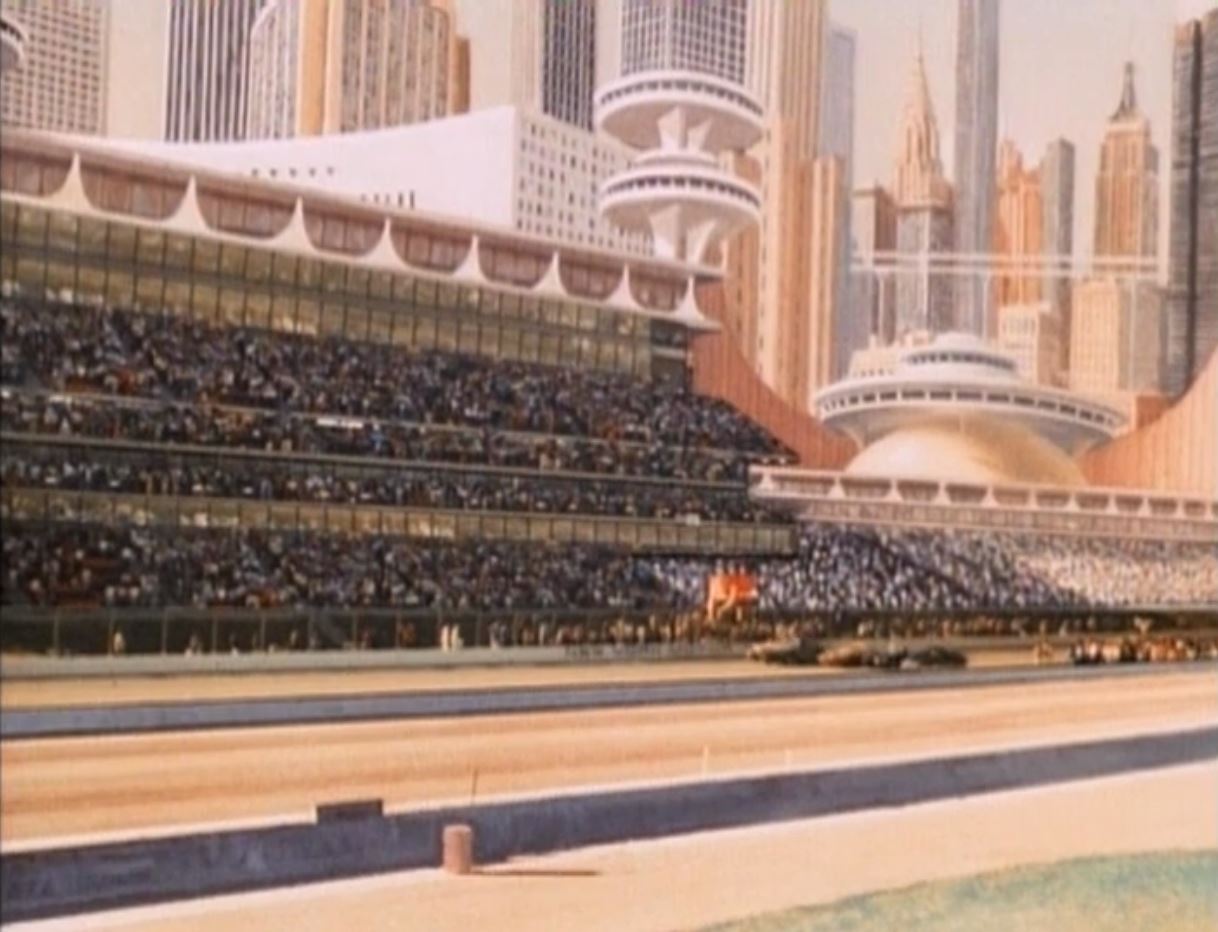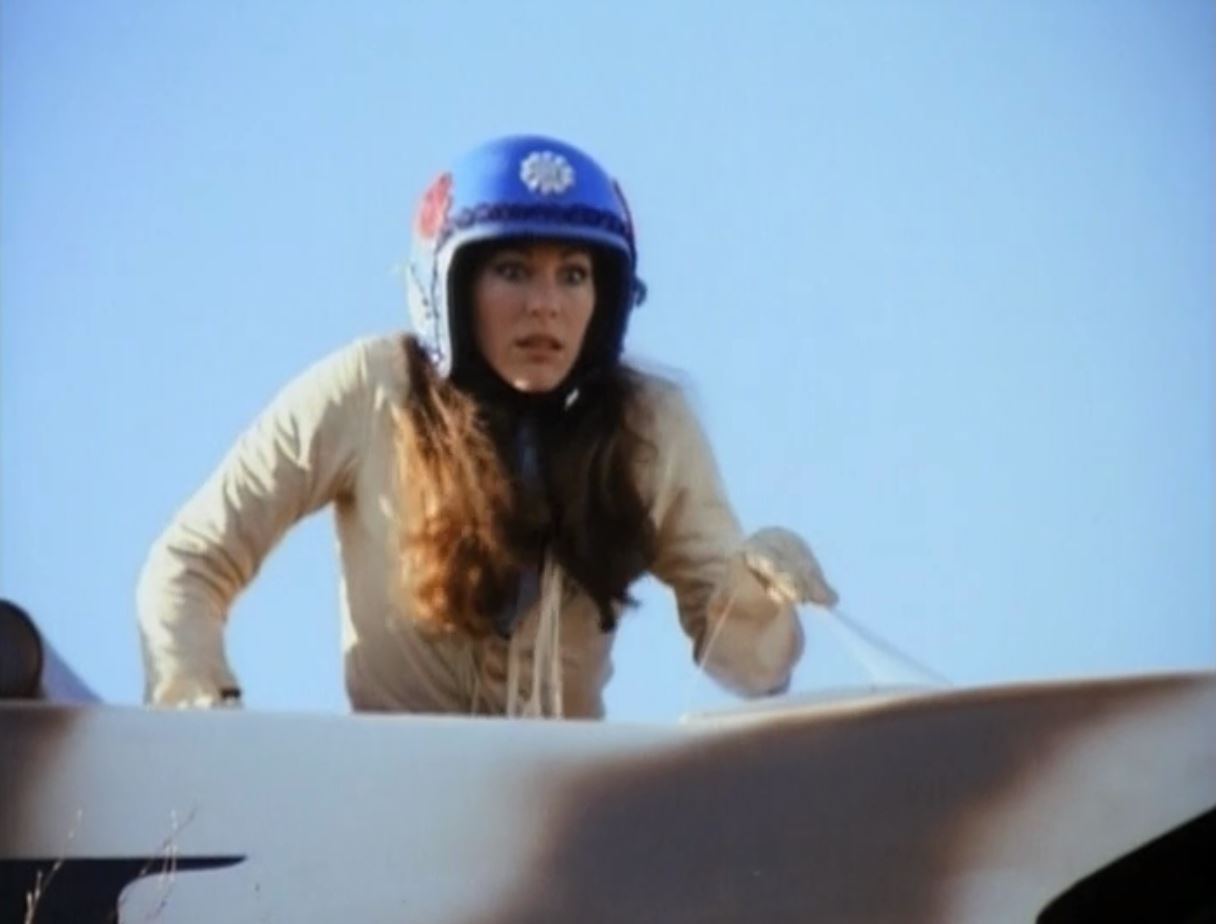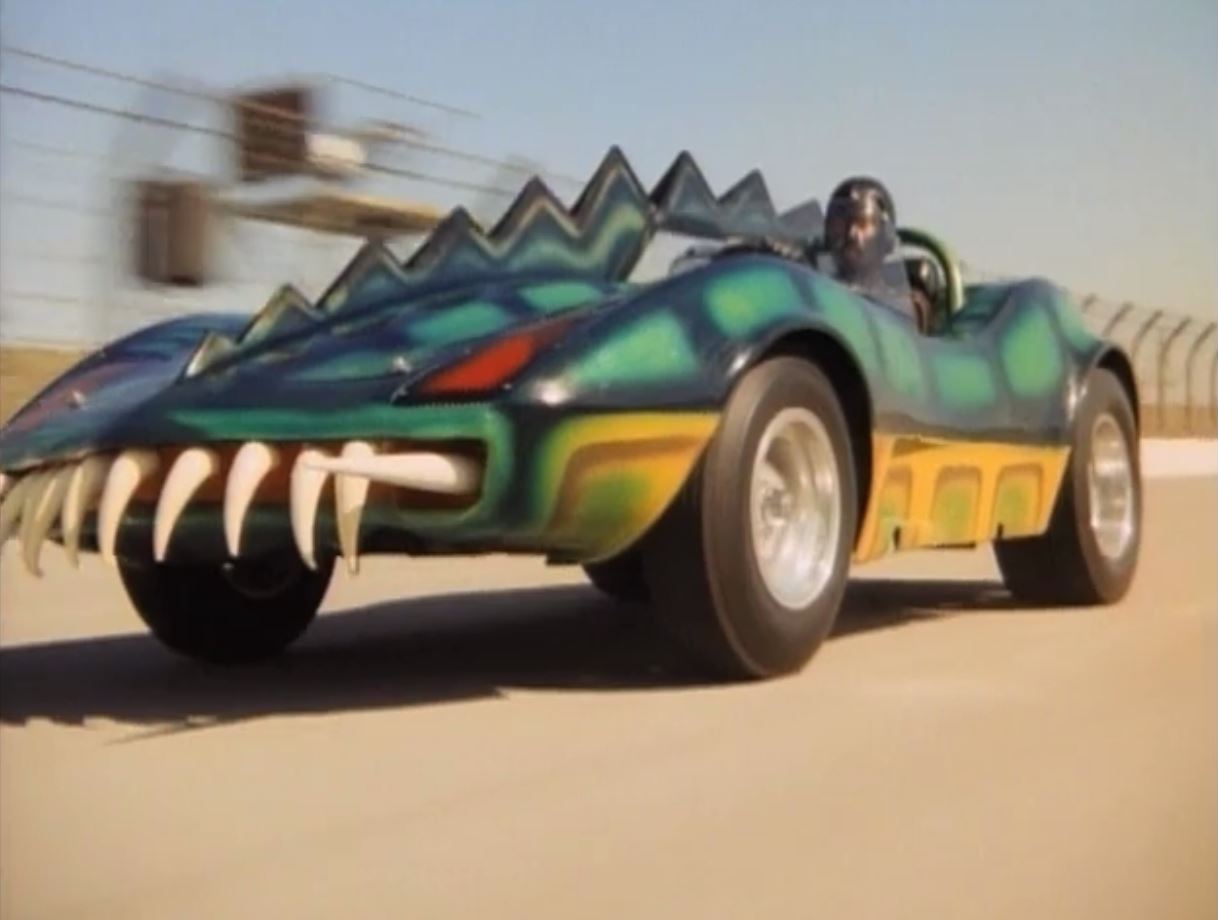Death Race 2000 and Rollerball (both 1975) show a dystopian corporate future in which the masses are appeased by bloody and ritual sports. It’s Death Race 2000 that holds the crown — sleazy, cheesy, action packed, and wallows in silliness for a shockingly concise 78 minutes. DR2K makes a bloody dash for the funny bone, often without special effects or women’s clothing.
Death Race 2000 stars John Carradine as the most vile national heroes that the United Provinces of America have ever produced, a disfigured homicidal racer who is close personal friends with the president. Looking into the character of Frankenstein it’s likely he’s some kind of dupe, like a fake wrestler. The story is that Frankenstein has been disfigured and damaged in his races and has been surgically rebuilt, but early on that’s revealed as a sham, making him some kind of corporate shill. Later it appears that some of it is true, at least inasmuch as his hand is not his own.
Mary Woronov (her website is here) plays one of the racers in Death Race 2000 — Calamity Jane — a gal too good-hearted it would seem to play a vicious hit and run killer. Mary Woronov had worked underground film, starting back in the day with Andy Warhol, and she joined director Paul Bartel in Eating Raoul (1982) hugely underrated comedy in which a normal boring Los Angeles couple discover a murderous way to fund their restaurant business. Bartel said that Eating Raoul was inspired by Kind Hearts and Coronets and The Ladykillers, although it’s probable that Kind Hearts and Coronets was a hit and Eating Raoul wasn’t, was because in Kind Hearts and Coronets Alec Guinness only ever killed versions of himself. Presenting killers as heroes, as Paul Bartel discovered, is not completely straightforward — although in Death Race 2000 David Carradine does succeed as a very charismatic killer. But this is a cult film, and a very silly one at that.
Post-feminist viewers will be surprised at the casual nudity in Death Race 2000, as it’s something that isn’t seen anymore. In 1975 you’d have to picture Death Race 2000 released at a cinema house somewhere between the mainstream showhouse and the porn cinema, the cheap double and triple bill joints where anything went, and films — as typified by those of Roger Corman — contained violence and nudity as par for the course. So whereas in Death Race 2000 lost out to Rollerball in terms of box office, it nonetheless probably remains the King Lear of Grindhouse. Death Race 2000 is infamous for being one of Quentin Tarantino's all-time favourites and he even dedicated Death Proof to the writer of Death Race 2000, Charles B. Griffith.
Although Paul Bartel directed Death Race 2000, it’s always seen as a product of Roger Corman. With hundreds of movies to his credit, Corman is hard to ignore and his influence on cinema is incalculable. In his nearly-six-decades in the business, only about a dozen of Corman’s films failed to make a profit, and although he isn’t known for making high art, he still has a keen following, and can never be ignored by writers on film. Paul Bartel was less slick at making a profit over the years, and sank everything, including his mother’s house, into Eating Raoul. Despite not having directed much since then, he has had a great career as an actor, and you will have seen him in something, whether it’s Fame, Gremlins 2, The Pope Must Die and even the episode of The Comic Strip he directed, in which he plays Oscar Wilde.
Interestingly, someone in 1975 must have realised that Death Race 2000 had cult potential, because in 1976 Bartel shot another film about a coast to coast race also featuring David Carradine, this one called Cannonball (1976) or sometimes Carquake. Paul Bartel’s salary for directing Death Race 2000 in 1976 was $5,500.
The side story in Death Race 2000 concerns the American resistance movement, who could, like the race itself, have done with a better budget. Still however the resistance rustle up a sexy aeroplane for a thrilling and explosive chase, and deliver a rolling critique of the American love of violent entertainment, expressing their grievances by wearing blue overalls and attacking the state. It’s always interesting to see how these films dress the future. For example, in Rollerball some escalators painted orange, shot from an extreme angle, seem to suggest a technological and safe future. In Death Race 2000, it looks like sports halls have been fitted out with carpets and square furniture — and it’s very effective.
Death Race 2000 of course says more about 1975 than it does about 2000, but it isn’t stretching things to say that this unambitious slice of 1970s exploitation still has relevance today, describing an oppressive government using sport and spectacle to control the masses, an idea as old as Brave New World (1931).
There are a few strangely prescient touches, the most unusual of which in Death Race 2000 is the fact that all the domestic atrocities of its modern America are blamed on none other than — the French. The general critique of television is standard fare but the heroics of the mysterious character played by David Carradine are above and beyond the call of duty, even if they are not consistent throughout.
The world of Death Race 2000 was never set out to be fully realised, although it holds together fine. It’s a bloodthirsty and oppressed society, a world which came into being what the script describes as the World Crash of 1979, and like something from The Hunger Games, Death Race 2000 suggests a world where the poor must suffer in the name of minority privilege for the wealthy few.
The masses have forgone more comfort than they ever have in history, and good old New World Cinema, never shrinks from its ridiculous blasting of the status quo — the world in Death Race 2000 is the United Provinces of America, ‘the mightiest power in the known universe’, and which by 2000 has successfully colonised the earth; the flag has even changed so that instead of the stars there is now a fist.
The World President appears in an orange cloud of smoke, backed by pre-digital synths and harps. He is as sleazy as any disreputable car salesman may have been in 1975. The Trans-Continental Road Race, ‘which upholds the American tradition of ‘no holds barred’’, and in this world human rights have all but vanished, replaced by murder in the name of entertainment.
New World Pictures' budget stretched to five cars in their race, which you can picture as an upgraded Wacky Races, and generally he film of theses cars is very exciting, as they speed out of the Lincoln Tunnel, blast down empty highways, and bash each other about on smaller freeways and what look like farm roads.
It would not be safe to lay stress upon any conclusions made from the data concerning the future in Death Race 2000, because at best it can only afford corroborative evidence of what was happening in 1975. Tellingly however, Roger Corman began to produce Death Race 2000 when he heard about the upcoming James Caan feature Rollerball, which likewise features a violent sport. The two are worth comparing, and although Death Race 2000 cost $300,000 and Rollerball cost much more, there isn’t any competition between the two — Death Race 2000 is a much better film
However, Death Race 2000 is a comedy if it is anything at all, and although both it and Rollerball deal with the same kind of corporate dystopia that 40 years later Hollywood is still happy to peddle, Rollerball takes it all a little more seriously, and as a result the track and games sequences are good, but the rest is quite forgettable. Rollerball takes place after the world's nations have gone bankrupt, and the ‘Corporate Wars’ which have taken place, suggest something excitingly dystopian, the likes of which have come and gone.
It’s Rollerball that will generally be discussed with more gravitas for the simple reason of exposition, because at 78 minutes Death Race 2000 does away with exposition. Depth and back story are a good thing when they work, but often they don’t, and they probably only add pomp to Rollerball. Death Race 2000 of course does not take itself at all seriously,
Death Race 2000 is also film that gets better with age, and doesn’t date like Rollerball or Soylent Green (1973). With a firm dedication Death Race 2000 has something compelling taking place every minute, and it stretches envelopes in all and any direction necessary. Nobody who has seenDeath Race 2000 for example can forget euthanasia day at the hospital, a spectacle gladly detourned by the homicidal racer Frankenstein, who punishes the voyeuristic doctors rather than kill the suicidal old folks.
The scoring system in Death Race 2000 is so ludicrous that it is almost a cult of its own, separate from the film.
All right, all right, and yes-sirree! A clean hit! A perfect hit! And no pain for the target. Too bad the guy was only thirty-eight; just two years older, he'd have been worth three times the points.
Do check out the point system for Death Race 2000, if you’ve a minute. It admirably demonstrates the levels of taste employed:
As the cars roar into Pennsylvania, the cradle of liberty, it seems apparent that our citizens are staying off the streets, which may make scoring particularly difficult, even with this year's rule changes. To recap those revisions: women are still worth 10 points more than men in all age brackets, but teenagers now rack up 40 points, and toddlers under 12 now rate a big 70 points. The big score: anyone, any sex, over 75 years old has been upped to 100 points.
This was the same year as not just Rollerball, but The Stepford Wives, David Cronenberg’s Shivers and my own favourites at the time Escape to Witch Mountain and The Land that Time Forgot. Death Race 2000 however is usually contrasted to its remake, Death Race which while a fine enough action thriller, is twice as long and nothing to do with the original. Death Race (2008) with Jason Statham and Ian McShane, and its even more forgettable sequels, are perfectly serviceable for what they are — but they will never shine like their Grindhouse Grandaddy.
{AG rootFolder="/images/" thumbWidth="200" thumbHeight="120" thumbAutoSize="none" arrange="name" backgroundColor="ffffff" foregroundColor="808080" highliteColor="fea804" frame_width="500" frame_height="300" newImageTag="0" newImageTag_days="7" paginUse="0" paginImagesPerGallery="12" albumUse="1" showSignature="0" plainTextCaptions="0" ignoreError="1" ignoreAllError="0" template="classic" popupEngine="slimbox"}film_stills/death_race{/AG}



